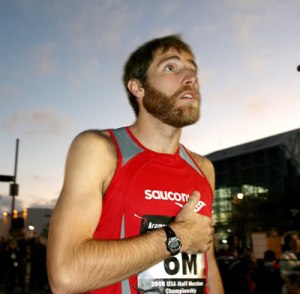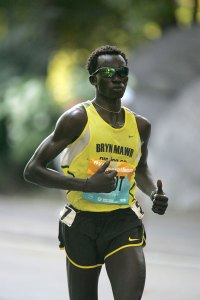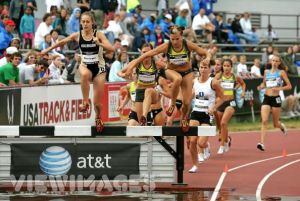Michael’s fall training was a disaster. He spent the summer as a cashier working at Yellowstone National Park. The set up, on paper, was perfect. He was at 8,000 feet, he had endless trails to train on, and he could spend time with his girlfriend. Jess is a year younger than Michael. She still has one more year of college left so they would not be able to see each other much since he was going to graduate school out of state. The image, as usual, did not pan out as expected. In actuality, Michael was working 45 hours a week in five days with double shift many days; he had to get up at 5:45am for work; and had less time to explore the park than he thought. In addition he found that he loved hiking and camping. Therefore his two off days from work were spent exploring the natural wonders of the park. He figured, “When else will I have the opportunity to live in a national park?” The summer was great. The training could be summed up in one workout.
From his dorm Michael ran a mile to the 7 Mile Hole Trail. 7 Mile Hole Trail is located in the Canyon section of the park. The run is seven miles downhill inching down to the river bottom of the canyon and then unforgivingly making you retrace your footsteps to the top. The dirt trail is about a four feet wide and undulates downward while zigzagging down the canyon. The workout was to get in twenty-five minutes of fartlek. Michael made it down five miles of trail then started back for home with a few alternating three and two minute intervals to go. He came off a bend in the trail while watching his footing on the rocky trail and noticed what look like two hikers and moved to the right hand side of the trail to let them pass. Five minute mile pace is not easy at altitude on a rocky trail so Michael got back to minding his footing. He looked up once again and found what he thought to be two hikers to be a sow and two bear cubs! Grizzlies are an aggressive creature when startled and even worse when with cubs. Sows will attack a male Grizzly for encroaching on their territory—Michael is about 1/5th the size of a Grizzly bear in Yellow Stone. Frightened Michael stopped dead in his tracks and with the uncanny precision of a runner who could meet his death stopped his watch to make sure his run time was accurate. The sow stopped and her cups which were flanking their mother stopped too. Michael looked at them; they looked at Michael. Michael moved into the woods to the right of the trail to allow them to pass. They stared and then, did the same. However their right was Michael’s left. They both stared at the other. The sow then gracefully allowed Michael leave of the situation and carried off into the woods—at stare down, they were twenty meters apart! Needless to say, between the threat of death and the arduous work hours, Michael was only able to train once a day—on days he could run—and ran only thirty to fifty miles per week.
Upon arrival at graduate school Michael quickly brought his mileage up to the 90’s and trained until club cross nationals in the beginning of December. It was a disaster. With this lesson learned Michael was much more tentative in the spring and stayed in the sixties for his half marathon training. Everything went great. His training pace was good, his Sunday runs were great, and his many tempo runs, cruise reps, intervals, and repeats were the best he has ever done.
Bang. They’re off. Each athlete is tentative; this is a 13.1 mile race—21 kilometers—no need to be the winner of mile one. Better weather could not be had. It is a late April morning and 50 degrees. The start is at the high school Michael graduated from five years earlier. This race is a homecoming in which he can now return to the town he grew up in a man. He last raced here as a matriculating schoolboy. Now he returns hardened from four years of the best training of his life in college and a year of training on his own. The first half mile is downhill then flattens out and winds to the road he grew up on—this is the mile marker. “Shit, 5:05. Too fast! That’s fine. Relax, you’re in 4th—that’s about right.” Mark Nickleson leads the field. He is a 21 year old 30:00 10k runner for Mid-Atlantic University. He is red shirting this year and this is the race he is peaking for. Right with Mark is 26 year old PhD student Matt Rabinowitz. Rabinowitz debuted in the marathon at New York this fall and had a bad experience trudging home the last three miles hellishly slow—he is out for redemption after a 70:00 half marathon a month ago. Michael is surrounded by some athletes he does not know.
The athletes turn left then make another left cutting through a paved path that leads through a small arboretum. Mark and Matt are out in front. Then the athletes come to MLK road and make a left. The 5:20’s feel surprisingly easy to Michael. His training has paid off. As Michael nears the turn-around he sees Mark out in front, Matt about twenty meters back battling it out by himself and a club runner about five seconds up on him. MLK was downhill going out. Now they must run two miles uphill to Covered Bridges Park where most of the race will be run before heading back to the high school track. Michael struggles to remain relaxed.
Michael enters into the cinder trailed park where his splits slow due to the terrain. He is all alone now out of touch with the three athletes ahead of him and in front of the rest of the field. He thinks back to the 18 mile long runs he did by himself in training out and back on the cinder rail trail. He thinks of all his tempo workouts. This is no different. Michael knew this may happen and now he will have to run the last eight miles of the half marathon solo. He comes out onto a road and off the cinders for 800m—he can instantly feel the added traction. He is quickly back onto the cinders as he nears the covered bridge turn around point. Before the bridge he must tackle two hills in the shape of a camels back—one immediately at the base of the other. He hits eight miles in 42:56. Good. The course then winds through the upper streets of the park with a mile long section of cinder still remaining. Michael’s father is at the covered bridge and starts following him from behind on a bicycle—he knows, just as Michael knows, that he is in no mans land. There are bands set up around the course and at ten miles Michael goes through in 53:45 hurting. About 200m later in the middle of a 300m uphill there is a solitary man of about 60 playing a ukulele singing a love song. This man is horribly out of place but just what Michael needs to get a smile on his face, relax, and get back to business and finish this race. As a sign of appreciation Michael lets the man know of his greatness, “You’re awesome!” he yells. The man’s awkwardness left Michael feeling good for about a mile then it was back to the pain of the race.
His legs are wobbly; he is doing everything he can to keep his stride frequency up; his stride is shorting—he is tying up. He has about 1000m to go in the race. He hears footsteps from behind. “There is no way I’m losing a kick!” There are 600m to get to the stadium, then he has to run up a short steep hill to enter the stadium, and finish running 300m in the stadium to the finish. Michael is all out now. To kick, at this point, is simply to maintain pace. He is trying to keep form. Michael goes by the last band of the course—a group of middle-aged hippies on the bongos rhythmically beating what sounds like a Native American War tune. Michael matches his stride to the beat of the drums and fights up the incline into the stadium. There are only 300m left. He still hears footsteps but can’t kick. He just tries to keep his cadence; he just tries to get on his toes but is struggling. With 100m to go Michael moves out to the edge of lane three to glide through the middle of finishing shoot. He finished his first ever half marathon in 1:11:17. He quickly turns around to see the athlete he held off. There is no one there. He entered the stadium with no other athlete in sight and finished with no other athlete in sight. He finished in the same position he was in at the mile marker.
“I gotta find a bigger race!”





